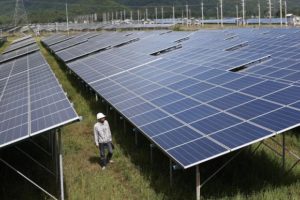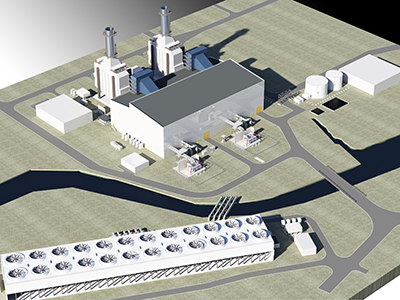
A solar power plant of Superblock, Southeast Asia’s biggest producer of solar power, in Phetchaburi province, Thailand
Thai renewables companies forced to seek opportunities abroad
Government control and rising competition mean less room for domestic growth
Thai renewable power companies operating solar and wind farms are shifting investment overseas, despite the government’s target of making renewables contribute up to 25% of the country’s total power mix by 2021. The state’s control over the market has intensified competition, leaving less breathing room for private businesses to grow domestically.
Impact Electrons Siam, a new-generation renewable power startup, has already moved to develop renewable projects in Japan and Laos.
Somboon Lertsuwannaroj, the company’s executive vice-president, said there were greater opportunities in Japan and neighboring countries in the Association of Southeast Asian Nations, where power demand is rising in line with economic growth and where governments are welcoming foreign investors into their power sectors.
“It is unlike [the situation in] Thailand, [where] the government has a monopoly on the power sector. The power rate in those countries is more attractively high compared to the power rate we are paid in Thailand,” said Somboon.
Somboon said Japan had become more open to foreign investors particularly since the country was hit by the 2011 earthquake and tsunami that caused the Fukushima nuclear disaster, which pushed Japan to implement more renewable power and be less dependant on fossil fuel-based or nuclear power.
“The power rate the Japanese government pays to operators is 40 yen per unit, or around $0.37, well above 4.12 baht ($0.13) the Thai government pays,” Somboon said.
Impact Electrons Siam operates a 13.7MW solar farm in Hiroshima and a 22MW solar farm in Hokkaido. The company is also developing a 600MW wind farm in Laos, which is the biggest wind project in ASEAN and is due to start operations by 2021.
Superblock Public Company is another Thai listed company that is seeking business opportunities abroad, particularly in Cambodia, Laos, Myanmar and Vietnam, where power demand has grown rapidly.
The company’s managing director Jormsup Lochaya said he was developing a 700MW wind farm in Vietnam, which is due to start operations in 2019, and is in talks with the local government about operating a solar farm in the near future.
“The power rate the Vietnamese government paid foreign investors is at $9.35 for solar and $9.80 for wind farms, which are very good rates,” Jormsup said, adding that his company also planned to invest more in renewable projects in the Philippines, Indonesia and Japan, with the aim of becoming a regional player.
Meanwhile, Ratchaburi Electricity Generating Holding Co., Thailand’s biggest private power company, is also expanding the proportion of renewable power in its portfolio, aiming to invest abroad.
It has a 34MW solar farm and a 144MW wind farm in Australia that are due to start commercial operations this year.
“We aim to raise the proportion of renewable power to 20% of total power generating capacity of 6,700MW this year, up from 15% in the previous year. And we are also looking for more opportunities abroad to help increase our capacity,” said Raluke Satayaporn, RATCH’s chief project development officer.
Thailand’s heavy reliance on imported fossil fuel-based energy at a time when gas reserves in the Gulf of Thailand were depleting rapidly has led the government to focus more on renewable power, mostly solar farms, wind farms and biomass power projects, in which the country has strong potential. Most of the liquefied natural gas currently used in generating the country’s power comes from two major gas blocks in the Gulf of Thailand. The country risks a shortfall of about 6,300MW of electricity in 2021.
Thailand has set a goal of having renewable power contribute up to 25% of its total power mix by 2021, according to the country’s Alternative Energy Development Plan 2012-2021, with a longer-term target of 40% by 2036.
That has opened up big opportunities for power companies to enter the renewables sector. Many companies have joined the Stock Exchange of Thailand, raising funds and competing for licenses to operate solar farms.
Currently, there are around 10 major renewable power generating companies listed on the SET with a combined market capitalization of more than 240 billion baht ($7.61 billion).
There are also many non-listed solar farm operators active in Thailand, pushing total renewable power generating capacity to 8,271MW, or around 42% of the target of 19,648MW by 2036.
However, as the Thai government recognized security issues related to the power generation business, it has completely monopolized the sector.
The energy ministry had allocated a combined power-generating capacity of about 300-400MW each year for licence allocation. That allowed private companies to operate renewable power plants generating less than 10MW, which intensified competition and left less room for domestic growth.
Thailand used to offer an above-market rate for power its state utility companies bought from private solar energy providers — of up to 8 baht ($0.25) per kilowatt hour — when it started promoting solar power around 10 years ago.
This was aimed at encouraging investors into the sector and eventually creating economies of scale to bring down the costs of solar power development.
The idea initially paid off as solar power development costs dropped sharply, allowing the government to cut the power rate in half to 4.12 baht per unit currently. However, this policy has now backfired as, with investment returns at home dropping, it has encouraged more companies to move to invest abroad.
Source: https://asia.nikkei.com/Business/Trends/Thai-renewable-power-companies-seek-opportunity-abroad


